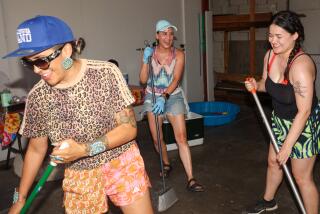Huts at School Help Sustain Tribe’s Heritage
- Share via
Students have turned back time in a corner of North Hollywood High School by building three Native American huts, replicas of those found in Tataviam villages that dotted the San Fernando and Santa Clarita valleys more than 1,500 years ago.
The huts--a sweat lodge, an acorn smoker and a dome-shaped house--are constructed of willow poles, cattails and bulrushes that students collected in Towsley Canyon in Santa Clarita and Wilson Canyon in Sylmar, under the guidance of Tataviam tribal members.
“Something like this keeps the tribe’s heritage alive and known,” said Rudy Ortega, 26, vice president of the tribal board. “A lot of people think the Tataviam have vanished. This shows we’re still around.”
The Tataviam settled in the area in A.D. 450, coexisting with neighboring Chumash and Tongva tribes. About 6,000 descendants live in Southern California today, Ortega said.
The students and their agricultural studies teacher, Rose Ormsby-Krueger, said they feel proud and happy about their yearlong effort and hope the village will stay up indefinitely.
“I want to be able to come back and see it,” junior Dejuan Wilson, 16, said Friday as he and several classmates tidied up the site. “When I have kids, I want to be able to bring them to see what we did.”
Ormsby-Krueger said she hopes such activities will help preserve not only Native American culture but also agricultural studies programs, which have vanished from all but a handful of Los Angeles Unified School District campuses.
The huts sit in a section of 5 1/2 acres fenced off as the school’s garden, where students grow fruits and vegetables and care for livestock. But on the crowded campus packed with portable classrooms, those 5 1/2 acres are “on the block” just about every year as possible sites for classroom expansion, she said.
Ormsby-Krueger has few illusions about why students sign up for agriculture classes. Few are planning to pursue careers in the field. Most take the classes as electives instead of band or art. But her classes are always full, she said.
Some of her students who built the huts hope to act as docents in coming semesters, giving presentations to visiting elementary pupils about the construction of the huts and Tataviam culture.
Ormsby-Krueger, a member of the Yaqui tribe of southern Arizona, said the goal was to incorporate agriculture classes into the project while providing something worthwhile for the community.
“This is a place children can come and observe what life was like here hundreds of years ago,” she said. “The students have done all the gatherings and made as close a replication as possible. This represents a lot of hard work and teamwork and responsibility. They learned a lot.”
More to Read
Sign up for Essential California
The most important California stories and recommendations in your inbox every morning.
You may occasionally receive promotional content from the Los Angeles Times.










